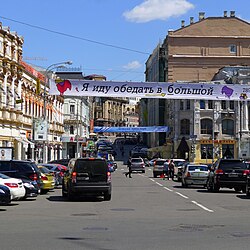Kuznetsky Bridge
| Кузнецкий Мост | |

Kuznetsky Most from Petrovka Street
|
|
| Location |
Moscow Central Administrative Okrug Meshchansky District Tverskoy District |
|---|---|
| Postal code | 125009, 107031 |
| Nearest metro station |
1 Okhotny Ryad 2 Teatralnaya 7 Kuznetsky Most 1 Lubyanka |
Kuznetsky Most (Russian: Кузне́цкий Мост, IPA: [kʊˈzʲnʲet͡skʲɪj ˈmost]) is a street in central Moscow, that runs from Bolshaya Dmitrovka Street to Lubyanka Street. The name, literally Blacksmith's Bridge, refers to the 18th-century bridge over Neglinnaya River, now running in an underground tunnel, and a nearby foundry and the settlement of its workers. Since the middle of 18th century, Kuznetsky Most was the street of fashion and expensive shopping.
The street is administered by Tverskoy District (west) and Meshchansky District (east).
Until the end of 15th century, Moscow was growing eastward, into Kitai-gorod. Prince Ivan III of Russia established his arsenal (Пушечный двор, Cannon Court) in the west, beyond Neglinnaya river. Later, he also set up a settlement of former Pskov residents, abducted from their hometown after the wars of the 1480s. Population grew slowly until the 1737 fire which razed the area.
Soon after the fire, the territory was built out with upper-class buildings and shops. Large territories north from the street were consolidated by the Vorontsov family estate. In 1754-57, architect Semyon Yakovlev built a stone bridge over Neglinnaya River to a design by Dmitry Ukhtomsky. The bridge over Neglinnaya lowlands extended 120 meters long and 12 meters wide; the shops between Kuznetsky Bridge and Vorontsov lands were literally standing on the edge of this bridge. The street was known as the home of notorious Darya Saltykova (1730-1801), condemned to life in prison for torturing her slaves.
The Fire of Moscow (1812) spared Kuznetsky Most, where Napoleon's Guards were stationed in defense of French colony in Moscow. In 1817-1819, the city locked Neglinnaya River in an underground tunnel and demolished the redundant bridge - excluding its norther wall that supported surviving buildings. Soon, the French colony returned and Kuznetsky Bridge became the street of bookstores, fashion and upper-class shopping, mostly managed by the French. Kuznetsky Most became the symbol of French influence on Russians, immortalized in Woe from Wit by Alexandr Griboyedov.
...
Wikipedia
